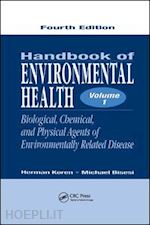The Handbook of Environmental Health-Biological, Chemical and Physical Agents of Environmentally Related Disease, Volume 1, Fourth Edition includes twelve chapters on a variety of topics basically following a standard chapter outline where applicable with the exception of chapters 1, 2 and 12. The outline is as follows:1. Background and status2. Scientific, technological and general information3. Statement of the problem4. Potential for intervention5. Some specific resources6. Standards, practices, and techniques7. Modes of surveillance and evaluation8. Various controls9. Summary of the chapter10. Research needs for the futureChapter 1, Environment and Humans discusses ecosystems, energy technologies and environmental problems, important concepts of chemistry, transport and alteration of chemicals in the environment, environmental economics, risk-benefit analysis, environmental health law, environmental impact statements, competencies for the environmental health practitioner.Chapter 2, Environmental Problems and Human Health has a general discussion of people and disease followed by a brief discussion of physiology including the human cell, blood, lymphatic system, tissue membranes, nervous system, respiratory system, gastrointestinal system and urinary system. There is a discussion of toxicological principles including toxicokinetics and toxicodynamics. There is a discussion of carcinogenesis, mutagenesis, reproductive toxicity and teratogenesis and the role of environmental contaminants in causing disease. Medical surveillance techniques utilized to measure potential toxicity are included. Basic concepts of microbiology are discussed followed by principles of communicable diseases and emerging infectious diseases. There’s an explanation of epidemiological principles including epidemiological investigations and environmental health and environmental epidemiology. The chapter concludes with a discussion of risk assessment and risk management.Chapter 3, Food Protection discusses food microbiology, reproduction and growth of microorganisms, environmental effects on bacteria, detergents and disinfectants, sources of foodborne disease exposure, FoodNet, various foodborne infections, bacterial food poisoning, chemical poisoning, poisonous plants and fungi, allergic reactions, parasitic infections, chronic aftereffects of foodborne disease, vessel sanitation programs, food quality protection acts, plans review, food service facilities, food storage, inspection techniques, preparation and serving of food, cleaning and sanitizing equipment and utensils, insect and rodent control, flow systems, epidemiological study techniques, Hazard Analysis and Critical Control Point Inspection, food protection controls, food service training programs, national food safety initiative. Chapter 4, Food Technology discusses emerging or reemerging foodborne pathogens, chemistry of foods, food additives and preservatives, food spoilage, pesticides and fertilizers in food, antibiotics in food, heavy metals and the food chain, use of recycled plastics in food packaging, environmental problems in milk processing, poultry processing, egg processing, meat processing, fish and shellfish processing, produce processing, and imported foods. National standards, practices and techniques are provided for milk, ice cream, poultry, eggs, meat, produce and seafood. Current modes of surveillance and evaluation as well as appropriate control measures are provided for each of the above areas.Chapter 5, Insect Control discusses scientific, technological, and general information about various insects of public health significance including fleas, flies, lice, mites, mosquitoes, and roaches. There is a substantial discussion of the many diseases transmitted by insects including African Bite Fever, Bubonic Plague, Chagas Disease, Colorado Tick Fever, Dengue Fever, Ehrlichioses, Encephalitis, Lyme Disease, Malaria, Rickettsial Pox, Rocky Mountain Spotted Fever, Scabies, Scrub











